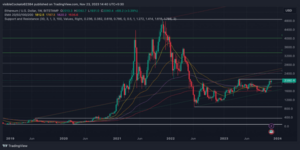
Over the past few weeks, Ethereum (ETH) has experienced significant growth and price movements. As of Nov. 23, the price of Ethereum was around $2,083, indicating a 14% increase over the previous month. One of the notable developments is the launch of a new Ethereum layer 2 network called Blast. Investors showed interest by adding over $30 million in Ether and stablecoins to this platform shortly after its launch.
Adding to Ethereum’s recent momentum, institutions have shown significant interest. The world’s largest asset manager, BlackRock, has filed for an ETH exchange-traded fund (ETF) named iShares.
Let’s examine Ethereum’s current landscape and analyze the factors affecting its price.
Factors Affecting Ethereum Price
Several key factors have influenced Ethereum’s recent performance, each playing a distinct role in shaping its price trajectory.
Interest Rates
Similar to other cryptocurrencies, ETH encounters broader economic challenges that could limit its price action. A rise in short-term interest rates reduces the stimulus for capital flows into the crypto market, which affects the price of Ethereum. Experts suggest that if US authorities manage to handle high rates in traditional finance smoothly, it could positively affect ETH’s price, but this might not happen until the middle of next year.
Increased Network Activity
Ethereum’s network activity has recently experienced a notable surge. In the first week of November, $250 billion worth of transactions took place on the Ethereum network, the highest since mid-March. During the same period, Ethereum’s revenue, derived from transaction fees, exceeded $30 million for two consecutive weeks. This indicated a significant increase compared to the yearly low of $12 million in early October.
Capital Influx
The recent influx of funds into the crypto space also affected the ETH. According to Glassnode data, funds are entering the cryptocurrency market through stablecoins, marking the first such influx in over a year.
The increase in stablecoin supply suggests potential buying pressure, as these assets are commonly used to buy cryptocurrencies or for margin in derivatives trading. These inflows and the sustained interest in Ethereum and its ecosystem are shaping the current movement of ETH’s price.
ETH Price Analysis
Ethereum has shown a positive trend in the past few weeks, trading above the important $2,000 support level.

At present, the value of ETH is placed well above the 50-day Exponential Moving Average (EMA) at $1787 and the 100-day EMA at $1820, indicating a continued bullish trend. Keep an eye on the critical levels at $2,130 and $2,000. The $2,130 level is a crucial resistance point, while the $2,000 level needs to hold strong support to maintain the current uptrend.
A clear break above $2,120 could trigger another significant rally, possibly targeting resistance levels at $2,200, $2,250, and even $2,320. However, if ETH can’t surpass the $2,120 resistance, a downward correction can occur.
Ethereum Price Prediction
The forecast for ETH has generated significant attention, especially in light of recent trends and analysis. Delving into various Ethereum predictions, CoinCodex predicts ETH to rise to $2,214 by Dec. 15, 2023. The company also suggests that ETH will significantly increase to $6,469 by 2024.
Another analytical source, Changelly, contributes to the discussion about Ethereum’s future with its own price forecast. Changelly expects the price of ETH to be around $2,190 this year. Looking ahead, they predict Ethereum to reach $3,244 in 2024 and go up to $4,853 by 2025. However, investors should approach these predictions with caution and awareness. The crypto market is highly volatile and unpredictable.
The crypto market is experiencing notable changes, especially with the speculation of Bitcoin and Ethereum spot ETFs, which are the main factors influencing the potential value of ETH. Getting approval for spot ETFs for Bitcoin and Ethereum would be a significant milestone for the crypto industry. It would reflect that regulatory authorities and the traditional financial sector accept and recognize cryptocurrencies.








